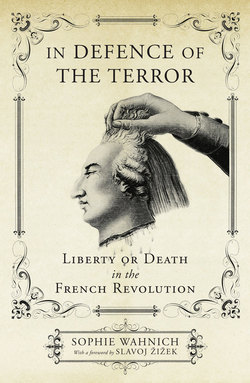In Defence of the Terror

Реклама. ООО «ЛитРес», ИНН: 7719571260.
Оглавление
Sophie Wahnich. In Defence of the Terror
Отрывок из книги
IN DEFENCE
OF THE TERROR
.....
There definitely is a lot of darkness in the dense Congolese jungle – but its heart lies elsewhere, in the bright executive offices of our banks and high-tech companies. In order to truly awaken from the capitalist ‘dogmatic dream’ (as Kant would have put it) and see this other true heart of darkness, one should re-apply to our situation Brecht’s old quip from The Threepenny Opera: ‘What is the robbing of a bank compared to the founding of a new bank?’ What is the stealing of a couple of thousand dollars, for which one goes to prison, compared to financial speculations which deprive tens of millions of their homes and savings, and are then rewarded by state help of sublime grandeur? What is a Congolese local warlord compared to the enlightened and ecologically sensitive Western CEO? Maybe José Saramago was right when, in a 2008 newspaper column, he proposed treating the big bank managers and others responsible for the meltdown as perpetrators of crimes against humanity whose place is in the Hague Tribunal. Maybe one should not wave this proposal off as a poetic exaggeration in the style of Jonathan Swift, but take it seriously.
Taking into account this violence which is part of the normal functioning of global capitalism also compels us to throw a new light on its opposite, revolutionary terror. One should in no way cover up the harshness of the early Bolshevik rule – the point is elsewhere: precisely when they resorted to terror (and they often did it, openly calling the beast by its name: ‘Red Terror’), this terror was of a different type from Stalinist terror. In Stalin’s time, the symbolic status of the terror thoroughly changed – terror was turned into the publicly non-acknowledged, obscene, shadowy supplement to official discourse. It is significant that the climax of terror (1936–37) took place after the new constitution was accepted in 1935. This constitution was supposed to end the state of emergency and mark a return of things to normality: the suspension of the civil rights of whole strata of the population (kulaks, ex-capitalists) was rescinded, the right to vote was now universal, and so on and so forth. The key idea of this constitution was that now, after the stabilization of the socialist order and the annihilation of the enemy classes, the Soviet Union was no longer a class society: the subject of the state was no longer the working class (workers and peasants), but the people. However, this does not mean that the Stalinist constitution was a simple hypocrisy which concealed the social reality. To the contrary, the possibility of terror is inscribed into its very core: since the class war was proclaimed to be over and the Soviet Union was conceived of as the classless country of the People, those who opposed the regime (or were easily presumed to) became no longer ‘class enemies’ in a conflict that tore at the social body, but enemies of the People – insects, worthless scum to be excluded from humanity itself.
.....